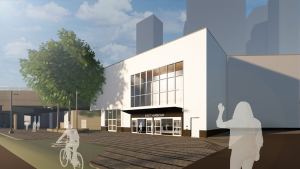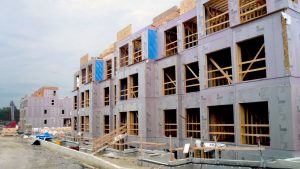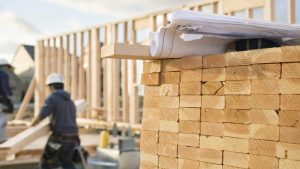Ventilation can be a powerful tool in preventing the spread of COVID-19, especially as inclement weather sets in and construction workers are in closer quarters or warming stations.
Conditions are especially challenging for construction industry as it deals with shielded or partially constructed buildings when weather is a consideration to renovations that have an operating HVAC systems in place. Authorities point out that finding the right ventilation protocol will depend on the building site and that ventilation is only another layer in the defence against the virus spread. Yet, it remains an important facet.
The Canadian Union of Public Employees (CUPE) lists good ventilation in works spaces as critical. “Many employers have focused on personal protective equipment (PPE) as the first and last line of defence to protect workers. In fact, PPE is considered the least desirable means of controlling a hazard,” CUPE said on its national website where it provides information on ventilation.
The Ontario government has also looked at ventilation as a means of eliminating air-borne COVID-19 particulate that can spread and related it to contained construction spaces. “The risk of COVID-19 transmission is higher in more enclosed and crowded spaces. On a construction site this may include trailers, sheds, temporary buildings and any other indoor spaces, finished or unfinished,” the Ontario Ministry of Labour, Trades and Skills Training said. In October, Ontario manufacturers, warehouses, and construction sites were the leading source of cases other than schools.
In B.C., WorkSafeBC’s directive on halting communicable diseases spread sets out a duty of the employer to provide a safe workplace. “WorkSafeBC has requirements for communicable disease prevention that applies to workplaces including proper building ventilation,” WorkSafeBC communications officer Samantha Pinto said. “Part 4 of the OHS Regulations outlines requirements on all mechanical heating, ventilation and HVAC systems. This information is summarized for employers on our website, which includes information on ventilation and air circulation as it relates to lowering the risk of COVID-19 transmission in the workplace.”
Trent Bancarz, communication advisor for the Alberta and Immigrations ministry, said employers are required to assess and control hazards at a workplace under Alberta’s Occupation Health and Safety laws. “This includes hazards related to COVID-19. Depending on the situation at a worksite, a number of control options for COVID-19 related hazards, including ventilation, could be required. If a ventilation system is used, it must comply with requirements outlined in the OHS Code.” Additional information on ventilation systems and COVID-19 can be found at Canadian Centre for Occupational Health and Safety which has a page on ventilation (https://www.ccohs.ca/covid19/indoor-ventilation).
The Public Health Agency of Canada (PHAC) has developed its own guide to indoor ventilation as the virus can be spread in two ways. The droplets vary in size from large droplets that fall to the ground rapidly near an infected person to smaller aerosols droplets lingering in the air. The airborne droplets can build up in concentration if an infected person stays within an enclosed indoor space with little air circulation over an extended period. The virus can lodge in mucous membranes such as eyes, nose and mouth or large droplets land on surfaces where they can be transferred to clothing or hands.
The PHAC website points out that these clouds of aerosol droplets building up can infect individuals moving through them or if the concentration becomes dense, drift to another person. It can also be moved by air currents. This is different from one person infecting another employee through verbal contact. PHAC also warns that ineffective ventilation or fans can move these aerosol and large droplets to other employees, even if they are working two metres apart.
“Opening windows in winter may not always be comfortable or possible,” the PHAC site said, but adds that even opening the windows for a few minutes can improve air quality (unless there is a safety hazard such as falling). It also recommends during employee breaks, ventilating the workspace when it is empty.
The Standard Protocol for Saskatchewan for COVID formulated by construction and safety groups in the province does not deal with ventilation but does note that rather than congregate in lunchrooms, employees should consider eating lunch in their vehicles when weather permits. The Calgary Construction Association (CCA) suggests in its protocol for dealing with COVID in lunchrooms that employees can eat in shifts to reduce numbers in one room but “if air circulation is a concern install negative air units and vent outside lunchroom.”
CCA’s president Bill Black said there are no specific ventilation guidelines in place and most employers on construction sites are staying with basic health protocol such as PPE, social distancing, and cleaning job sites with some now moving to mandatory vaccination. “Last winter there were no such measures in place (for ventilation) and we had no major incidents,” he said, but the protocol in place and approved by Alberta’s major construction associations does provide for limiting the numbers of individuals in specific work areas.
The jury is still out on the use of portable air filtration systems but new information from studies indicates HEPA filter devices may be useful. Both WorkSafeBC guidelines and PHAC maintain that HEPA filters have been shown to reduce particulate and some viruses but data on COVID is not yet available.
However, new research is emerging. In June, a United Kingdom study has shown HEPA filters in portable units are effective although the study results have not been peer reviewed. University of Cambridge researchers conducted a study in two repurposed COVID-19 units (which had no ventilation) in Addenbrooke’s Hospital, Cambridge, U.K., between January and February 2021. During this time, the alpha variant (lineage B1.1.7) accounted for more than 80 per cent of the circulating SARS-CoV-2. Despite healthcare workers using appropriate personal protective equipment (PPE) with the capacity to filter medium and large size droplets, viral transmission from patients to hospital staff was commonplace, attributed to the inhalation of very small viral aerosols. The study found that portable air filtration systems—capable of combining high-efficiency particulate filtration and UV light sterilization—were most effective in warding off respiratory SARS-CoV-2.











Recent Comments
comments for this post are closed